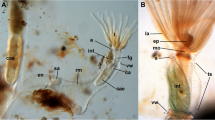Abstract
The body-cavity ultrastructure of two species of colonial Kamptozoa is investigated in detail. The body cavity is separated from all surrounding tissues by a basal lamina, which underlies the ectodermal and endodermal epithelia and covers the excretory system, gonads, muscular cells, and nerves that cross the body cavity. The basal lamina does not cover the body-cavity cells, which, in respect to this feature, can be classified as connective-tissue cells. Several types of cells were identified in the body cavity of the calyx: amoeboid cells, dark spindle-shaped cells, cells containing phagosomes, cells of dorsoventral bundles, and cells adjoining the surface of the internal organs (gonads, digestive and nervous systems). The tubular cells of the stalk and stolon, as well as the amoeboid cells of the stolon, are described. The body cavity of Kamptozoa is characterized by features that allow interpreting it as a hemocoel.
Similar content being viewed by others
References
Abrikosov, G.G., Class Kamptozoa, Manual, vol. 1, Moscow, Leningrad: Biomedgiz, 1937, pp. 765–775.
Borisanova, A.O., Chernyshev, A.V., and Malakhova, V.V., Structure of the masculature in Barentsia discreta (Busk, 1886) (Kamptozoa, Coloniales), Russ. J. Mar. Biol., 2012, vol. 38, no. 1, pp. 22–34.
Dogel, V.A., Zoologiya pozvonochnykh (Zoology of Invertebrates), Moscow: Vysshaya shkola, 1981.
Atkins, D., The ciliary, feeding mechanism of the entoproct Polyzoa, and a comparison with that of the ectoproct Polyzoa, Quart. J. Microsc. Sci., 1932, vol. 75, pp. 393–423.
Ax, P., Multicellular Animals, vol. 2: The Phylogenetic System of the Metazoa, Springer, 2000.
Bartolomaeus, Th., Die Leibeshöhlenverhältnisse und Nephridialorgane der Bilateria, Ultrastruktur, Entwicklung und Evolution, Göttingen: Habilitationsschrift der Georg-August-Universität Göttingen, 1993.
Brien, P., Classe des Endoproctes ou Kamptozoaries, in Traité Zoology, Paris: Masson et Cie, 1959, vol. 5, part 1, pp. 927–1007.
Emschermann, P., Les Kamptozoaires, état actuel de nos connaissances sur leur anatomie leur développement, leur biologie et leur position phylogénétique, Bull. Soc. Zool. France, 1982, vol. 107, no. 2, pp. 317–344.
Franke, M., Ultrastructure of the protonephridia in Loxosomella fauveli, Barentsia matsushimana and Pedicellina cernua,Implications for the protonephridia in the ground pattern of the Entoprocta (Kamptozoa), Microfauna Mar., 1993, vol. 8, pp. 7–38.
Harmer, S.F., On the structure and development of Loxosoma,Quart. J. Microsc. Sci., 1885, vol. 25, pp. 261–337.
Haszprunar, G. and Wanninger, A., On the fine structure of the creeping larva of Loxosomella murmanica: additional evidence for a clade of Kamptozoa (Entoprocta) and Mollusca, Acta Zool., 2008, vol. 89, pp. 137–148.
Hausdorf, B., Helmkampf, M., Meyer, A., et al., Spiralian phylogenomics supports the resurrection of Bryozoa comprising Ectoprocta and Entoprocta, Mol. Biol. Evol., 2007, vol. 24, pp. 2723–2729.
Hyman, L.H., The Invertebrates, Vol. 3: Acanthocephala, Aschelminthes and Entoprocta, The Pseudocoelomate Bilateralia, New York: McGraw-Hill, 1951.
Mariscal, R.N., The adult and larval morphology and life history of the entoproct Barentsia gracilis (M. Sars, 1835), J. Morphol., 1965, vol. 116, pp. 311–338.
Mukai, H. and Makioka, T., Some observations on the sex differentiation of an entoproct, Barentsia discreta (Busk), J. Exp. Zool., 1980, vol. 213, no. 1, pp. 45–59.
Nickerson, W.S., On Loxosoma davenporti sp. nov., An entoproct from the New England coast, J. Morphol., 1901, vol. 17, no. 3, pp. 351–381.
Nielsen, C., Entoproct life-cycles and the entoproct/ectoproct relationships, Ophelia, 1971, vol. 9, no. 2, pp. 209–341.
Nielsen, C. The relationships of Entoprocta, Ectoprocta and Phoronida, Am. Zool., 1977, vol. 17, no. 1, pp. 149–150.
Nielsen, C., Animal Evolution: Interrelationships of the Living Phyla, Oxford: Oxford Univ. Press, 2012, 3d ed.
Nielsen, C., Jespersen, Å., Entoprocta, in Microscopic Anatomy of Invertebrates, New York: Wiley, 1997, vol. 13, pp. 13–43.
Ruppert, E.E., Introduction to the aschelminth phyla: a consideration of mesoderm, body cavites, and cuticle, in Microscopic Anatomy of Invertebrates, New York: Wiley, 1991, vol. 4, pp. 1–17.
Ruppert, E.E., Fox, R.S., and Barnes, R.D., Invertebrate Zoology, A Functional Evolutionary Approach, Thomson-Brooks/Cole, 2004, 7th ed.
Author information
Authors and Affiliations
Corresponding author
Additional information
Original Russian Text © A.O. Borisanova, A.V. Chernyshev, V.V. Malakhov, 2014, published in Biologiya Morya.
Rights and permissions
About this article
Cite this article
Borisanova, A.O., Chernyshev, A.V. & Malakhov, V.V. The structure of the body cavity Pedicellina cernua (Pallas, 1775) and Barentsia discreta (Busk, 1886) (Kamptozoa, Coloniales). Russ J Mar Biol 40, 426–439 (2014). https://doi.org/10.1134/S1063074014060133
Received:
Published:
Issue Date:
DOI: https://doi.org/10.1134/S1063074014060133




